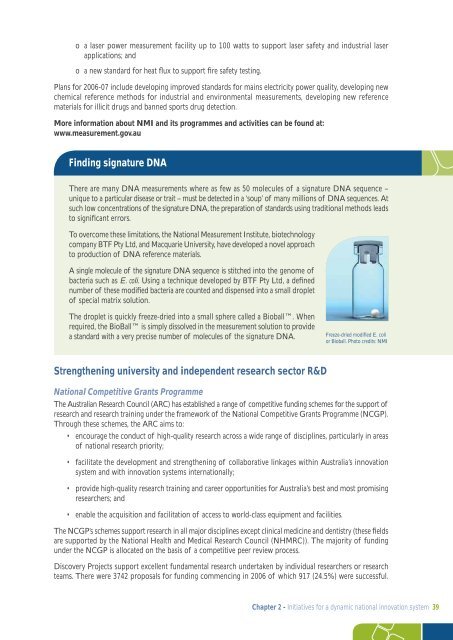The Australian Government's Innovation Report
The Australian Government's Innovation Report
The Australian Government's Innovation Report
You also want an ePaper? Increase the reach of your titles
YUMPU automatically turns print PDFs into web optimized ePapers that Google loves.
o a laser power measurement facility up to 100 watts to support laser safety and industrial laser<br />
applications; and<br />
o a new standard for heat flux to support fire safety testing.<br />
Plans for 2006-07 include developing improved standards for mains electricity power quality, developing new<br />
chemical reference methods for industrial and environmental measurements, developing new reference<br />
materials for illicit drugs and banned sports drug detection.<br />
More information about NMI and its programmes and activities can be found at:<br />
www.measurement.gov.au<br />
Finding signature DNA<br />
<strong>The</strong>re are many DNA measurements where as few as 50 molecules of a signature DNA sequence –<br />
unique to a particular disease or trait – must be detected in a ‘soup’ of many millions of DNA sequences. At<br />
such low concen trations of the signature DNA, the preparation of standards using traditional methods leads<br />
to significant errors.<br />
To overcome these limitations, the National Measurement Institute, biotechnology<br />
company BTF Pty Ltd, and Macquarie University, have developed a novel approach<br />
to production of DNA reference materials.<br />
A single molecule of the signature DNA sequence is stitched into the genome of<br />
bacteria such as E. coli. Using a technique developed by BTF Pty Ltd, a defined<br />
number of these modified bacteria are counted and dispensed into a small droplet<br />
of special matrix solution.<br />
<strong>The</strong> droplet is quickly freeze-dried into a small sphere called a Bioball. When<br />
required, the BioBall is simply dissolved in the measurement solution to provide<br />
a standard with a very precise number of molecules of the signature DNA.<br />
Freeze-dried modified E. coli<br />
or Bioball. Photo credits: NMI<br />
Strengthening university and independent research sector R&D<br />
National Competitive Grants Programme<br />
<strong>The</strong> <strong>Australian</strong> Research Council (ARC) has established a range of competitive funding schemes for the support of<br />
research and research training under the framework of the National Competitive Grants Programme (NCGP).<br />
Through these schemes, the ARC aims to:<br />
• encourage the conduct of high-quality research across a wide range of disciplines, particularly in areas<br />
of national research priority;<br />
• facilitate the development and strengthening of collaborative linkages within Australia’s innovation<br />
system and with innovation systems internationally;<br />
• provide high-quality research training and career opportunities for Australia’s best and most promising<br />
researchers; and<br />
• enable the acquisition and facilitation of access to world-class equipment and facilities.<br />
<strong>The</strong> NCGP’s schemes support research in all major disciplines except clinical medicine and dentistry (these fields<br />
are supported by the National Health and Medical Research Council (NHMRC)). <strong>The</strong> majority of funding<br />
under the NCGP is allocated on the basis of a competitive peer review process.<br />
Discovery Projects support excellent fundamental research undertaken by individual researchers or research<br />
teams. <strong>The</strong>re were 3742 proposals for funding commencing in 2006 of which 917 (24.5%) were successful.<br />
Chapter 2 - Initiatives for a dynamic national innovation system 39












![[Tam] Uygula[ya] - Bilim, Teknoloji ve Ä°novasyon Politikaları TartıÅma ...](https://img.yumpu.com/36820041/1/184x260/tam-uygulaya-bilim-teknoloji-ve-anovasyon-politikalara-tartaama-.jpg?quality=85)



